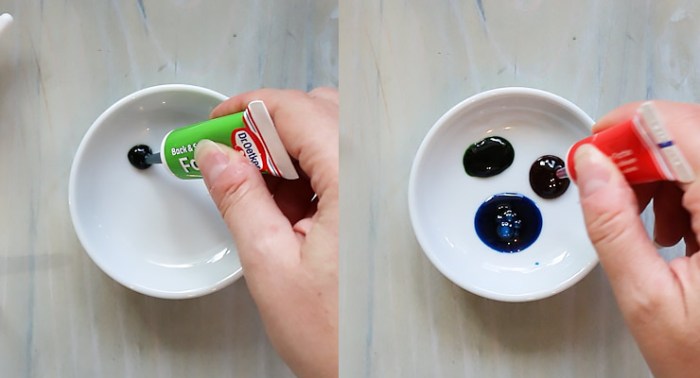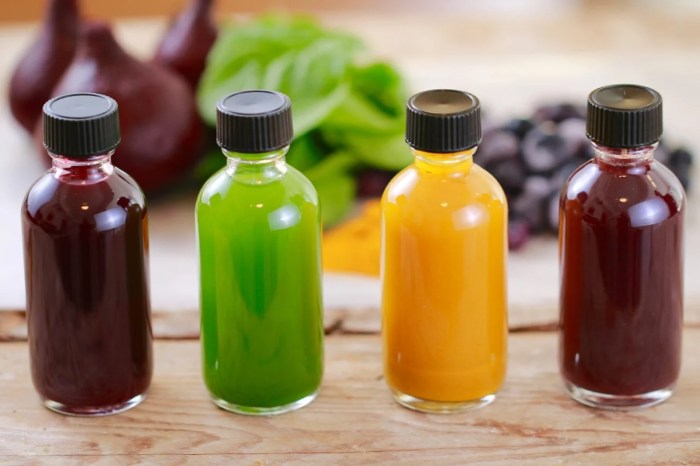Using White Food Coloring in Recipes

How do you make white food coloring – White food coloring, while seemingly simple, offers a surprising versatility in culinary applications. It’s not just about achieving pure white; it’s about enhancing existing colors, creating a clean canvas for other hues, and subtly altering the overall appearance of dishes for a more polished and professional look. This section explores the practical uses of white food coloring in various recipes and provides guidance on its successful integration.
So, you want to know how to make white food coloring? It’s simpler than you think; often, it’s just a matter of using ingredients like powdered sugar or cornstarch. But to understand the broader picture of food coloring, it helps to know what foods already contain it, which is why checking out this list of what foods have food coloring in them is useful.
This gives you a better sense of the range of colors and ingredients used, helping you understand how to achieve a pure white in your own creations. Ultimately, creating white food coloring often comes down to careful ingredient selection and achieving the right consistency.
White Food Coloring Applications in Recipes
White food coloring finds its niche in recipes where a bright, pure white or an intensified shade is desired. It’s often used to counteract yellowing in buttercream frostings, create a stark contrast against vibrant colors, or to achieve a perfectly opaque white in fondant decorations. The subtle brightening effect can also elevate the visual appeal of candies, icings, and even certain beverages.
Incorporating White Food Coloring into Different Food Types
The method of incorporating white food coloring varies depending on the food type. For frostings and icings, it’s best to add the coloring gradually, mixing thoroughly to avoid clumping. Start with a small amount and add more until the desired shade is achieved. Fondant requires a slightly different approach; knead the coloring into the fondant until it’s evenly distributed throughout.
For beverages, a small amount of white coloring can create a milky or opaque effect, but be mindful of potential texture changes.
Impact of White Food Coloring on Taste and Texture
In most cases, white food coloring has a negligible impact on the taste and texture of food. High-quality food-grade coloring is designed to be flavorless and odorless. However, excessive use might slightly alter the texture, particularly in frostings, making them slightly stiffer. Always use a reputable brand and follow the instructions carefully to minimize any unintended effects.
Recipes Showcasing White Food Coloring
The following recipes demonstrate the versatility of white food coloring:
- Bright White Buttercream Frosting: For a 2-cup batch of buttercream frosting, add 1-2 drops of white food coloring until the desired bright white is achieved. Note that the starting color of your butter and other ingredients will influence the amount of coloring needed.
- Opaquely White Fondant: When working with a pound of fondant, start by adding a few drops of white food coloring and kneading it thoroughly. Add more gradually until the fondant achieves a consistent, bright white color without becoming too stiff.
- Milky White Chocolate Beverage: Add a single drop of white food coloring to a cup of warm milk or white chocolate drink for a subtly enhanced, more opaque appearance. Too much coloring can make the drink look unnatural.
- White Chocolate Truffles with a Hint of Brightness: When making white chocolate truffles, adding a tiny amount of white food coloring can enhance the brightness and pure white color of the chocolate, resulting in a more visually appealing treat.
Alternatives to Commercial White Food Coloring

While commercial white food coloring offers convenience, exploring alternatives using readily available household ingredients can be both cost-effective and provide a deeper understanding of food coloring principles. This section details several methods for creating homemade white food coloring, compares their efficacy and safety to commercial options, and addresses potential limitations.
Creating White Food Coloring with Household Ingredients
Several household ingredients can contribute to a whitening effect in food, although achieving the intense, pure white of commercial options may be challenging. The effectiveness depends heavily on the recipe and the desired outcome. Remember that these alternatives might subtly alter the flavor or texture of your food.
White Food Coloring from Cornstarch
To create a white food coloring using cornstarch, begin by mixing one tablespoon of cornstarch with two tablespoons of cold water. This initial mixture will be a cloudy, off-white slurry, quite thick in consistency. Gradually whisk in more cold water until you achieve a smooth, thin paste. The color will remain a pale, opaque white. This paste can then be added to recipes requiring a thickening and whitening agent, such as frostings or sauces.
The final consistency will depend on the recipe; adding this cornstarch mixture will generally increase the thickness.
White Food Coloring from Heavy Cream or Milk
Heavy cream or whole milk offers a different approach to achieving a whiter appearance in food. The inherent white color of the cream or milk can brighten lighter-colored recipes. Start with a small amount and gradually incorporate it. The color will be a creamy white, and the consistency will depend on the quantity added and the original recipe.
For example, adding heavy cream to a light-colored frosting will lighten its shade and impart a richer texture. The initial appearance is a rich, opaque white liquid; adding it to a recipe may result in a slightly less intense white depending on the base.
White Food Coloring from Titanium Dioxide (Caution Advised)
Titanium dioxide is a naturally occurring white pigment often used as a food additive (E171). However, its safety is currently under review by some regulatory bodies. If using, ensure it’s food-grade and follow package instructions meticulously. It’s a fine, white powder. When mixed with water, it creates a thick, opaque white suspension.
The color is a bright, pure white, but achieving a smooth consistency requires careful mixing to prevent clumping. It’s crucial to note that some research suggests potential health concerns, so proceeding with caution and thorough research is advised. The final product will be a thick, white paste.
Comparison of Homemade and Commercial White Food Coloring
Commercial white food coloring typically offers a brighter, more intense white and a consistent, easily-dispersed color. Homemade alternatives often result in a less intense white, potentially impacting the final appearance of the food. In terms of safety, commercial food colorings undergo rigorous testing, while the safety of homemade alternatives depends entirely on the ingredients used and their purity. Always prioritize food-grade ingredients when creating homemade options.
Limitations and Drawbacks of Homemade White Food Coloring, How do you make white food coloring
Homemade white food colorings may lack the intensity and consistency of commercial products. They can also alter the flavor or texture of the recipe, sometimes negatively. The shelf life of homemade versions is typically shorter than that of commercially produced food coloring. Additionally, sourcing and handling ingredients may introduce unexpected variables, potentially affecting the final color or texture.
Safety and Considerations: How Do You Make White Food Coloring

While white food coloring generally poses minimal risk when used as directed, understanding its potential impact on health and the environment, along with proper handling and disposal, is crucial for responsible use. This section addresses potential health concerns, safe storage and handling practices, environmental impact, and provides a comprehensive safety guideline for both commercial and homemade white food coloring.
Potential Health Concerns
The primary health concern associated with white food coloring consumption stems from potential additives and impurities. Commercial white food coloring may contain titanium dioxide (TiO2), a widely used pigment. While generally considered safe at low levels by regulatory bodies like the FDA (in the US) and EFSA (in Europe), some studies have raised concerns about potential long-term health effects, particularly with high and prolonged exposure.
These studies, however, are often ongoing and require further research to establish definitive conclusions. Furthermore, allergic reactions, though rare, are possible. Individuals with known sensitivities to specific food additives should always check the ingredient list carefully before using any food coloring. Homemade white food coloring, using natural ingredients like rice flour or cornstarch, generally presents lower health risks, but cross-contamination during preparation should be carefully avoided, especially if preparing for individuals with allergies.
Storage and Handling of White Food Coloring
Proper storage and handling are essential to maintain the quality and safety of white food coloring. Commercial food coloring should be stored in a cool, dark, and dry place, away from direct sunlight and heat sources. This helps prevent degradation and maintains its effectiveness. The container should be tightly sealed to prevent moisture absorption or contamination. Homemade white food coloring, if not used immediately, should be stored in airtight containers in the refrigerator for a limited time, usually no more than a week.
Always practice good hygiene when handling food coloring; wash your hands before and after use to prevent contamination.
Environmental Impact of White Food Coloring
The environmental impact of white food coloring is primarily linked to the production and disposal of titanium dioxide. The mining and processing of titanium dioxide can have detrimental effects on the environment, including habitat destruction and water pollution. Disposal of titanium dioxide-containing food coloring requires careful consideration. While small amounts in wastewater are unlikely to pose significant environmental risks, large-scale disposal should adhere to local regulations.
Using natural alternatives, like rice flour or cornstarch, minimizes the environmental footprint associated with the production and disposal of food coloring.
Safety Guideline for Use and Disposal
Always follow the manufacturer’s instructions for use and dosage when using commercial white food coloring.
For homemade white food coloring, ensure ingredients are of food-grade quality and prepared in a clean environment. Avoid cross-contamination with other foods. Always label containers clearly, indicating the type of food coloring and the date of preparation. Dispose of both commercial and homemade white food coloring responsibly, following local regulations for waste disposal. For small amounts, disposal through regular wastewater systems is usually acceptable.
Larger quantities might require specialized disposal methods. Regular cleaning of equipment and surfaces used in food coloring preparation is also essential to maintain hygiene and prevent contamination.
Key Questions Answered
Can I use cornstarch as white food coloring?
Yes, cornstarch can add a slight white tint, but it’s not as effective as other options and might alter texture.
Is titanium dioxide safe to eat?
The safety of titanium dioxide is currently under review by some regulatory bodies. Check current regulations in your region.
How long does homemade white food coloring last?
Homemade versions generally have a shorter shelf life than commercial ones. Store in an airtight container in a cool, dark place and use within a week or two.
Where can I buy food-grade titanium dioxide?
You can usually find it online from specialty baking supply stores or chemical suppliers.

